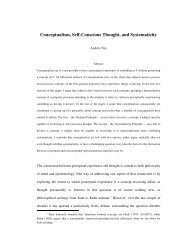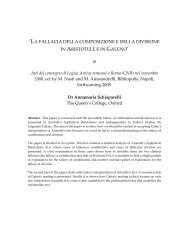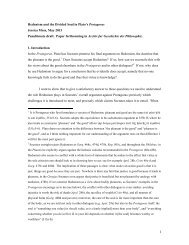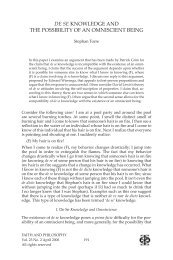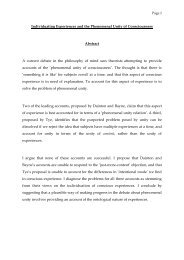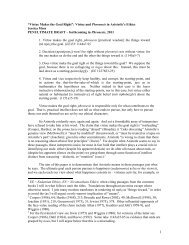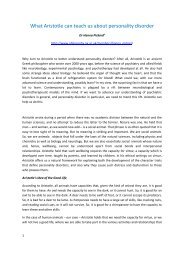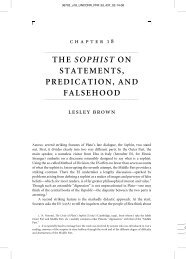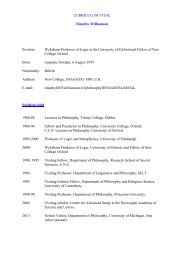Say who everyone is as you go along - Faculty of Philosophy ...
Say who everyone is as you go along - Faculty of Philosophy ...
Say who everyone is as you go along - Faculty of Philosophy ...
You also want an ePaper? Increase the reach of your titles
YUMPU automatically turns print PDFs into web optimized ePapers that Google loves.
8<br />
might be induced by shocks to rational thought such <strong>as</strong> exposure to irresolvable<br />
puzzles called koans (in the Rinzai school <strong>of</strong> Zen) or by sitting motionless for long<br />
periods (in Soto Zen). Every person <strong>is</strong> already enlightened so it would be a<br />
m<strong>is</strong>understanding <strong>of</strong> Enlightenment to construe it <strong>as</strong> a future state to be attained.<br />
Enlightenment <strong>is</strong> realized by detachment from desire and habitual means to end<br />
thinking, and their eventual cessation. Th<strong>is</strong> cannot be done by will power, only <strong>as</strong> a<br />
consequence <strong>of</strong> meditation or other Zen Buddh<strong>is</strong>t practices. Trying to be<br />
Enlightened, <strong>as</strong> well <strong>as</strong> construing Enlightenment <strong>as</strong> future, are obstacles to<br />
Enlightenment, that <strong>is</strong>, being at one with one’s true Enlightened state. Once the<br />
present h<strong>as</strong> been pol<strong>is</strong>hed clean like a mirror by meditation, Enlightenment <strong>is</strong><br />
d<strong>is</strong>closed <strong>as</strong> already all here now. Although Zen <strong>is</strong> intensely practical, experiential<br />
and non-lingu<strong>is</strong>tic, and the medium <strong>of</strong> philosophy <strong>is</strong> language, in its ins<strong>is</strong>tence on the<br />
ineffable Zen h<strong>as</strong> an affinity with the later Aquin<strong>as</strong> and the early Wittgenstein <strong>who</strong><br />
each thought philosophy reaches a certain limit in what cannot be said.<br />
Zen w<strong>as</strong> founded in China by Bodhidharma, <strong>who</strong> brought the doctrines <strong>of</strong> the<br />
Lanka-Vatara Sutra from India the late 5th century. The genes<strong>is</strong> <strong>of</strong> Zen arguably lies<br />
in the fusion <strong>of</strong> Bodhidharma’s Buddh<strong>is</strong>m with Chinese Tao. Bodhidharma w<strong>as</strong><br />
succeeded <strong>as</strong> m<strong>as</strong>ter by Hui-k'o (487—593). The Zen emph<strong>as</strong><strong>is</strong> on practice rather<br />
than doctrine <strong>is</strong> well shown by Hui-neng (638—713), the sixth patriarch <strong>of</strong> Chinese<br />
Zen, <strong>who</strong> w<strong>as</strong> both enlightened and illiterate. Ma-tsu, Nan-chuan, Huang-po, Lin-chi,<br />
and Chao-chou were m<strong>as</strong>ters during the <strong>go</strong>lden age <strong>of</strong> Zen in the 8th and 9th<br />
centuries. Scripture and doctrine were regarded <strong>as</strong> unimportant, or even <strong>as</strong><br />
hinderances, to the realization <strong>of</strong> one’s Enlightenment. Instead, there w<strong>as</strong> an<br />
emph<strong>as</strong><strong>is</strong> on self-d<strong>is</strong>cipline, oral instruction and testing dialogue. Sometimes a monk<br />
might be suddenly hit with a cane, for example if their alert meditation shaded <strong>of</strong>f<br />
into doziness.<br />
There w<strong>as</strong> severe persecution <strong>of</strong> Buddh<strong>is</strong>m in China in 845. However, Zen not<br />
only survived due to its <strong>is</strong>olation in mountain mon<strong>as</strong>teries, but w<strong>as</strong> left <strong>as</strong> the most<br />
practiced form <strong>of</strong> Buddh<strong>is</strong>m in China. As a result <strong>of</strong> the persecution, Zen divided into<br />
two principal schools: Lin-chi and Ts'ao-tung. These were brought to Japan in the<br />
14 th century where they were known <strong>as</strong> Rinzai Zen and Soto Zen respectively.<br />
In Soto Zen there <strong>is</strong> an emph<strong>as</strong><strong>is</strong> on just sitting. As early <strong>as</strong> Bodhidharma there<br />
had been the practice <strong>of</strong> looking at the wall. (The present author remembers long<br />
periods sitting looking at a whitew<strong>as</strong>hed wall in the 1970’s. I, and others, <strong>as</strong>ked<br />
‘Why are we looking at the wall?’ Our monk would only ever reply ‘Look at the<br />
wall!’) Just sitting <strong>is</strong> the kind <strong>of</strong> meditation known <strong>as</strong> zazen. That there <strong>is</strong> no point, or<br />
no overtly stated point, to zazen allows a me<strong>as</strong>ure <strong>of</strong> deconditioning, a falling away<br />
<strong>of</strong> the repetitive ordinary mind. It would not be completely wrong to say zazen<br />
therefore h<strong>as</strong> a point after all: deconditioning, detachment, Enlightenment, but th<strong>is</strong><br />
could be m<strong>is</strong>leading. If zazen <strong>is</strong> done with th<strong>is</strong> (or anything) <strong>as</strong> a <strong>go</strong>al in mind,<br />
paradoxically, ‘the <strong>go</strong>al’ cannot be ‘reached’. Indeed, <strong>as</strong> we have seen,<br />
Enlightenment <strong>is</strong> not a <strong>go</strong>al in the sense <strong>of</strong> a future state. The gate <strong>is</strong> a gateless gate.



